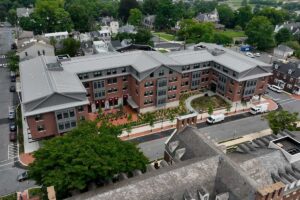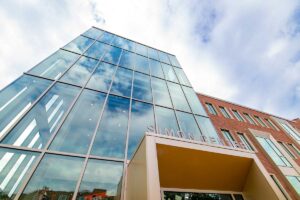McCartney II and Simon Center earn LEED Silver certification
By Stella Katsipoutis-Varkanis

McCartney Street Housing Phase II | Photo by Alfred Greenbaum
In February, Lafayette’s McCartney Street Housing Phase II and William E. Simon Center for Economics and Business each earned a prestigious Silver certification from Leadership in Energy and Environmental Design (LEED)—the world’s most widely used green building rating system.
Achieving LEED Silver, explains Delicia Nahman, Sustainability Director, takes considerable effort. “It demonstrates Lafayette’s commitment to thoughtful considerations around material sourcing, natural lighting, resource consumption, and health and wellness of building occupants,” she says.
A globally recognized symbol of sustainability achievement, LEED certification provides a framework for healthy, highly efficient, and cost-saving green buildings that offer environmental, social, and governance benefits. “It’s a way for us to better think through how buildings can be constructed and operated in the most environmentally friendly and efficient way possible,” says Samantha Comas, sustainability outreach and engagement manager.
LEED certification is a foundational design consideration that’s taken into account from the outset of a building project: “Questions like what energy system to use, how to manage and retain stormwater, what landscaping we select, and how to provide natural light and address thermal comfort of occupants are constant conversations at every part of the design and construction phase,” Nahman says.

William E. Simon Center for Economics and Business | Photo by Adam Atkinson
To achieve LEED certification, a building project earns points by adhering to LEED’s prerequisites and credits that address carbon, energy, water, waste, transportation, materials, health, and indoor environmental quality. Projects go through a verification and review process, and are awarded points that correspond to a level of LEED certification: Certified (40-49 points), Silver (50-59 points), Gold (60-79 points), and Platinum (80+ points).
The construction and design of McCartney II and Simon Center boast various LEED features. Just over 65%, or 357.58 tons, of McCartney II’s construction waste was diverted from landfills—the equivalent weight of more than 55 adult elephants. Its water fixture selections also save over 1.2 million gallons of water per year, and the building demonstrates nearly 30% energy use savings (equivalent to $15,000 annual cost savings). Simon Center features LED lighting, gray linoleum floors made from recycled material, alcoves with quiet seating areas, and an outdoor study and relaxation area surrounded by native plants.
McCartney II and Simon Center join a number of other Lafayette buildings that have been LEED-certified, including Rockwell Integrated Sciences Center, Oechsle Center for Global Education, and Grossman House, among others. Each is a demonstration of Lafayette’s carbon neutrality commitment, which details steps to be taken by the College to increase energy efficiency and conservation, and reduce environmental impact. The policy, explains Comas, also states that any major renovation or new construction on campus must meet LEED Silver standards or higher. “Building energy usage and waste are integral to Lafayette’s ambitious Climate Action Plan goals to achieve carbon neutrality and 60% waste diversion from landfill by 2035,” she says.
In addition to physically manifesting the College’s sustainability principles, Nahman says, building to LEED standards presents opportunities for students to play an active role in the certification process as well as the College’s overall sustainability goals. “We utilize the built environment and these projects in a meaningful way that bridges operational impact and our academic mission,” she says. “Students are often brought in to listen to conversations during the process, and we also take ideas from classes and feed them into these specific project discussions.”
It also sets a positive example for students, Comas adds: “To have these buildings that can go above and beyond in operational efficiencies is really important and exciting to students, especially those who are interested in living sustainable lives. They can point to this and say, this is the gold standard, and this is what I want to see—not only as a student here on campus but in my life beyond Lafayette.”

